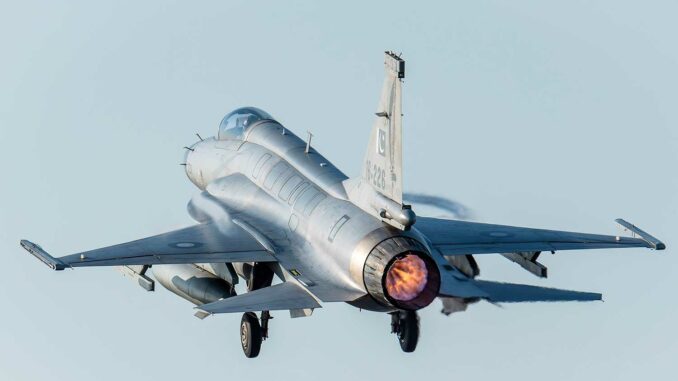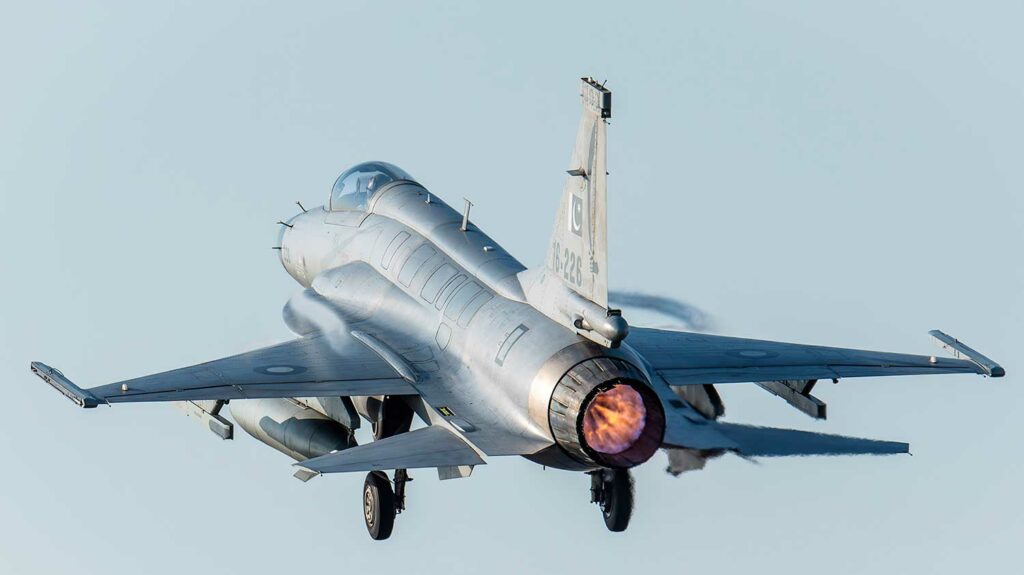
Images of JF-17s on Azerbaijani runways are causing a stir on social media. Deployment for exercises or first deliveries to Baku? Analysis, figures and regional issues.
Summary
On 19 October 2025, images of JF-17 fighter jets circulated from Azerbaijani bases, fuelling speculation about a delivery to the Azerbaijani Air Force. Verifiable facts show that this was primarily a deployment by the Pakistan Air Force for a bilateral exercise, with JF-17 Block III aircraft flown non-stop thanks to in-flight refuelling. This presence comes at a time when Baku has signed successive contracts with Islamabad to acquire these aircraft: an initial agreement announced in 2024, followed by an expansion in 2025 involving up to 40 aircraft. The confusion arises from the coincidence between these announcements and the arrival of Pakistani aircraft on local runways. Beyond the controversy, the JF-17 Block III provides the Azerbaijani Air Force with a credible and more affordable option for renewing its post-Karabakh fleet, with AESA radar, BVR missiles and logistics compatible with its resources. The transfer schedule, serial numbers and operational integration into Baku’s doctrine remain to be clarified.
The event of 19 October 2025 and the nature of the aircraft
Photos and videos released on 19 October 2025 show JF-17s stationed in Azerbaijan. On the same day, the Pakistan Air Force announced the arrival of a detachment of JF-17 Block III aircraft for the bilateral Indus Shield Alpha exercise. The timeline is clear: the Pakistani deployment is official and documented, with direct flight transport supported by an Il-78. The temptation to see this as a delivery is understandable, but the authorities have not announced the transfer of aircraft to the Azerbaijani forces. The confusion therefore stems from the coincidence between the training and the previous contracts made public. For the time being, the aircraft observed are identified as belonging to Pakistan, with PAF crews and support. Online speculation is not sufficient to qualify this arrival as a transfer of ownership. The factual points to follow are the registrations, markings and the possible presence of Azerbaijani technicians in a leading role.
The Azerbaijani-Pakistani contract and its figures
Baku has been interested in the JF-17 for a long time. A government agreement was announced in 2024, without detailed public figures. In 2025, several sources reported an increase to 40 aircraft for an aggregate amount of up to several billion dollars. The most frequently cited figures are an initial package worth around $1.6 billion, followed by an extension worth approximately $4.6 billion for 40 aircraft, including training and armaments. These amounts generally include the complete chain: airframes, engines, air-to-air and air-to-ground weapons, simulators, spare parts and initial training. However, it should be noted that the exact breakdown (tranches, options, delivery phases) is not always made public, and that the overall values often aggregate multi-year batches. For Azerbaijan, the interest is twofold: securing an allied supplier and avoiding political and ITAR export constraints that could complicate other options.
The JF-17 Block III programme and its key capabilities
The JF-17 Block III is the most modern iteration of the fighter co-developed by Chengdu (China) and PAC Kamra (Pakistan). It incorporates a KLJ-7A AESA radar, a helmet-mounted display, an electronic warfare suite, a missile approach warning system and the use of latest-generation BVR missiles. The PL-15E provides credible BVR range, with an export envelope generally considered to be inferior to the Chinese domestic versions, but superior to the SD-10/PL-12 generation. Block III retains a top speed of around Mach 1.6, a ceiling of around 16,000 m, and a combat range of around 1,300 km (depending on configuration and profiles). The payload is close to 3.4 t, distributed over 7 to 8 hardpoints depending on sources and pylon options. The engine remains based on the RD-93 family, with recurring discussions about the integration of a more powerful RD-93MA version or, eventually, a Chinese equivalent. The operational message is simple: Block III upgrades the detection, data link and BVR lethality of a lightweight, cost-controlled platform.
The modernisation sought by Baku after Nagorno-Karabakh
After 2020 and 2023, Baku is prioritising air defence, MALE/loitering drones and precision strike. The renewal of combat aviation is a logical part of this movement, especially as the Soviet-era fleet is showing its limitations. The JF-17 is positioned as a modern ‘workhorse’, capable of providing air policing, BVR interception, guided ground support and anti-ship capabilities at a lower acquisition and operating cost than recent Western standards. For a budget of a few billion, Azerbaijan could field one and a half to two squadrons, train its crews, build up local maintenance capabilities and standardise a portfolio of Chinese-Pakistani munitions adapted to regional threats. The concrete and measurable challenge lies in the number of aircraft available online, the monthly availability rate, and the rate at which converted pilots can be ramped up.

Material evidence on the ground and the question of bases
Images from 19 October show JF-17s on Azerbaijani runways, with compatible reception facilities: taxiways, modernised hardened shelters, and potential logistical regrouping. Several sources mention the Nasosnaya base as a recently modernised site, with a longer runway and new shelters. Caution is needed: these developments could be used both to welcome allies on exercises and to prepare the reception infrastructure. The salient fact of 19 October is Pakistan’s projection capability, demonstrated by the 𝗿𝗮𝘃𝗶𝘁𝗮𝗶𝗹𝗹𝗲𝗺𝗲𝗻𝘁 𝗲𝗻 𝘃𝗼𝗹 and direct transit to the Caucasus. Technically, this validates the JF-17’s compatibility with deployed operations, which is reassuring for Baku, which is aiming for sovereignty and rapid interception missions in dense airspace.
Plausible delivery schedule scenarios
There are three possible scenarios. First scenario: the exercise serves as a dress rehearsal before the first official delivery of aircraft in the coming months, with Azerbaijani crews in advanced training. Second scenario: only the initial batches of equipment and training are delivered in 2025, with the airframes arriving in batches in 2026 depending on the industrial capacity of PAC Kamra. Third scenario: the PAF deploys its aircraft on an ad hoc basis to train Azerbaijani crews ‘in the field’, but the transfer of ownership and operation only takes place once the infrastructure and supply chain have been fully validated. The decisive factors will be the serial numbers, the appearance of permanent Azerbaijani markings, the signing of test flights by pilots from Baku, and official communication of acceptance by the Azerbaijani Ministry of Defence.
Regional implications for Eurasia
The Ankara-Islamabad-Baku triangle is growing stronger. It complements the transfers already observed in drones, loitering munitions and C4ISR. The entry into service of the JF-17 in Azerbaijan would change the equation for Yerevan, which is also modernising its air defence and fighter-bomber fleet with European and Middle Eastern partners. In doctrinal terms, having a fighter equipped with modern BVR missiles and AESA radar increases local deterrence. This is not an absolute game changer when compared to the Rafale, J-10C or F-16V, but rather a pragmatic catch-up in terms of capabilities, backed by a friendly supply chain. Joint exercises such as 𝗜𝗻𝗱𝘂𝘀 𝗦𝗵𝗶𝗲𝗹𝗱 𝗔𝗹𝗽𝗵𝗮 consolidate tactical interoperability and the sharing of lessons learned in a contested EM environment.
Technical limitations and points of attention
Several technical debates remain. First, the performance of the KLJ-7A compared to higher-end Western and Chinese AESA radars, which determines the optimal use of long-range missiles. Secondly, there is the question of motorisation: although the 𝗥𝗗-𝟵𝟯𝗠𝗔 is said to offer increased thrust, its export availability and schedule have yet to be confirmed. The integration of air-to-ground, anti-ship and anti-radiation weapons requires methodical testing and certification cycles, especially for a new operator. Finally, support capacity (availability rate, MRO, stocks) remains the crux of the matter: without a robust flow of parts and trained technicians, the acquisition cost advantage erodes. In short, the JF-17’s appeal will only become fully apparent if Baku secures the supply chain and achieves concrete monthly availability targets.
The cold reading of 19 October: a presence, not proof of transfer
The day of 19 October brings one solid fact — the presence of Pakistani JF-17s in Azerbaijan for training — and a set of clues consistent with a future delivery. It does not, on its own, constitute proof of an immediate transfer of ownership. The contracts are in place, the intention to modernise is clear, infrastructure preparations are progressing, but the formalisation of an initial Azerbaijani allocation requires additional visible and administrative elements. In the meantime, Azerbaijan is intelligently capitalising on high-level exercises to prepare its crews, test its bases and refine its doctrine of use. This is the fastest way to transform an order form into tangible air power.
War Wings Daily is an independant magazine.